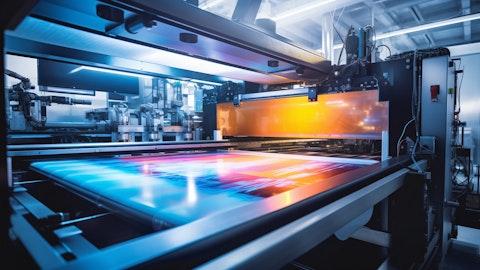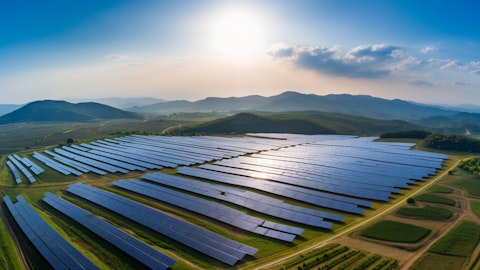Spectral AI, Inc. (NASDAQ:MDAI) Q3 2025 Earnings Call Transcript November 11, 2025
Operator: Good day, and welcome to the Spectral AI Inc. Q3 2025 Financial Results Conference Call. [Operator Instructions] Please note, this event is being recorded. I would now like to turn the conference over to Sara Prendergast, Assistant General Counsel. Please go ahead, ma’am.
Sara Prendergast: Thank you, Nick. Good afternoon, everyone, and thank you for joining us for Spectral AI’s 2025 Third Quarter Financial Results Conference Call. Our speakers for today will be Dr. DiMaio, the company’s Chairman of the Board; and Vincent Capone, the company’s Chief Financial Officer. Before we begin, I’d like to remind everyone that during this call, certain statements made are forward-looking statements within the meaning of the safe harbor provisions of the United States Private Securities Litigation Reform Act of 1995, including statements regarding the company’s strategy, plans, objectives, initiatives and financial outlook. When used in this call, the words estimates, projected, expects, anticipates, forecasts, plans, intends, believes, seeks, may, will, should, future, propose and variations of these words or similar expressions or the negative versions of such words or expressions are intended to identify forward-looking statements.
These forward-looking statements are not guarantees of future performance, conditions or results and involve a number of known and unknown risks, uncertainties, assumptions and other important factors, many of which are outside companies control that could cause actual results or outcomes to differ materially from those discussed in the forward-looking statements. As such, listeners are cautioned not to place undue reliance on any forward-looking statements. Investors should carefully consider the foregoing factors and the other risks and uncertainties described in the Risk Factors section of the company’s filings with the SEC, including the registration statement and the other documents filed by the company. These filings identify and address other important risks and uncertainties that could cause actual events and results to differ materially from those contained in the forward-looking statements.
With that, I would like to turn the call over to Dr. DiMaio, Spectral AI’s chairman of the Board.
John DiMaio: Sara, thank you very much, and good afternoon to everyone. We appreciate you joining us today for our third quarter financial results conference call. I am quite pleased to discuss with you our results of operations through the third quarter of 2025. As I’ve mentioned on previous earnings calls, I follow a mantra here at Spectral AI of Finance, Focus and finish. I believe we are moving forward in all three phases as we complete our 2025 calendar year. Following our FDA submission in the second quarter of 2025, we continue to work on developments in our DeepView system. I’d like to address additional developments in the third quarter of 2025 as following: number one, finance. Our cash balance has stayed flat at $10.5 million from the second quarter of 2025.
We continue to monitor our operating efficiencies and had a number of stock option and warrant exercises that contributed to the continued high level of cash reserves at our company. On top of that, as announced in October, we completed an additional registered direct offering of our common stock adding $7.6 million of additional cash reserves to the company’s balance sheet. With total cash on hand at the end of September 2025 of over $10 million, a closely managed spending rate and the additional funding from our registered direct offering, Spectral AI has a significant financing in hand for the foreseeable future that enables us to continue our work on our product commercialization efforts, including the planned U.S. launch of our DeepView system next year.
Number two, focus, which is the FDA submission. Our FDA submission, which was submitted in June of this year was a very big milestone in our company’s development. I am proud of our team for their hard work and dedication in meeting that very important time line. The submission is obviously a key driver in the evolution of our business. We continue to have further interactions with the FDA on our de novo application, albeit somewhat slowed with the current U.S. development — U.S. government shutdown that we’re all experiencing. We continue to move forward with the de novo application full speed ahead as we have stated. Number three, finish. Lastly, finish is what we continue to focus on as we look to our BARDA partners to bring the DeepView system and the device to the commercial marketplace.
We continue to focus on releasing next year and preparing to launch the commercialization strategy that we have discussed and will continue to refine as we move to that milestone. We continue to have a very broad application and indications that we seek in addition to burns for which we have a CPT 3 code and additional indications that will broaden the marketplace. We’ve had outstanding support from the burn community and at burn conferences with our abstracts being presented at national forums and publications and international publications. This further solidifies what’s happening with our system in addition to the support that is receiving from the burn and the wound community at large. I thank you again for your attention to our company.
And with that, I will turn things over to our Chief Financial Officer, Vince Capone. Vince?
Vincent Capone: Thank you, Dr. DiMaio. Thank you all for joining us this afternoon. We issued our earnings release this afternoon, which contains additional details of our operating results, and we will be filing our Form 10-Q with the SEC later this week as well. With that in mind, I will focus my remarks on select highlights and key items. Our research and development revenue in the third quarter of 2025 was reduced to $3.8 million from $8.2 million in the third quarter of last year. This reduction reflects our anticipated reduced reimbursements under the BARDA Project BioShield contract, which was awarded to the company in September of 2023. In the third quarter of 2025, following our FDA de novo submission, we have incurred less direct labor clinical trial and other reimbursed costs from the prior year’s quarter.
Gross margin decreased to 42.7% from 44.8% in the third quarter of last year due to a lower percentage of direct labor as a percentage of our total reimbursed costs under the BARDA Project BioShield contract from the prior year’s quarter. General and administrative expenses for the third quarter of 2025 were $5 million as compared to $4.6 million in the third quarter of 2024. This increase reflects increased third-party adviser and consulting costs and an increase in non-billable work that is not related to the BARDA Project BioShield contract. The company reported a net loss in the third quarter of 2025 of $3.6 million as compared to a net loss of $1.5 million in the prior year’s third quarter, again reflecting the reduced research and development revenue and the higher general and administrative expenses from the prior year third quarter.
Even with a $2.1 million increase in the net loss for the third quarter of 2025 as compared to the third quarter of 2024, the company is reporting a net loss of $8.6 million for the first nine months of 2025 as compared to a net loss of $7.4 million for the first nine months of 2024, reflecting our focus on managing our overall cost structure. At September 2025, we had 27,251,034 shares outstanding. Moving to our balance sheet. As Dr. DiMaio has previously noted, as of September 30, 2025, cash and cash equivalents totaled $10.5 million up from $5.2 million on December 31, 2024. Our cash balance has remained consistent since June 30, 2025. This is primarily due to the exercise of stock options and warrants in the third quarter of 2025 and our continued management of our operating expenses through the third quarter of 2025.
Please note that this cash balance does not include the gross proceeds of $7.6 million of additional funding the company received in connection with our registered direct offering in October 2025. With our large cash reserves, our focused approach on managing our operational costs and expenses, we believe this level of funding is sufficient to provide the company with the necessary capital for the foreseeable future. For 2025, we are reducing our revenue guidance from $21.5 million to $18.5 million. The reduced revenue guidance reflects the anticipated reduced work on our BARDA Project BioShield contract since the submission to the FDA and some timing effect from the U.S. government shutdown, which we believe will be largely made up within the first half of 2026.
Also note that our guidance does not include the contribution of any sales of the DeepView system for the burn indication in the United Kingdom or in Australia. Thank you for your time and attention today. And with that, operator, let’s open up the call for questions from our analysts.
Q&A Session
Follow Spectral Ai Inc. (NASDAQ:MDAI)
Follow Spectral Ai Inc. (NASDAQ:MDAI)
Receive real-time insider trading and news alerts
Operator: [Operator Instructions] And your first question today will come from Ryan Zimmerman with BTIG.
Unknown Analyst: This is Izzy on for Ryan. So Vince, I heard your commentary about the impact of the government shutdown and how that played into timing. But I was hoping you could provide a little bit more color around exactly what has been impacted and just confirm that everything is still on track for that expected first half ’26 approval?
Vincent Capone: Sure. Izzy. Thanks for participating on the call. Yes, Izzy, we continue to see our FDA submission. We don’t see any holdups in our FDA submission into 2026. Actually excited this week if we can get the government to lift the shutdown. But some of our conversations with BARDA, some of the conversations we have with their teams and the team involved with the continued development of our DeepView system, some of that has been delayed and ultimately, we just see it as a timing issue for the most part, understanding that nothing has changed with the delivery of what we hope and anticipate that we will get FDA clearance of our device in the first half of 2026 and also the continued work through the BARDA contract, which I’m sure you’re aware, that runs through the end of the first quarter of 2026, at least the base phase. So no, other than that, I mean, it’s just really a general slowdown in work with our BARDA partners. I hope that answered your question.
Unknown Analyst: Yes, it does. It’s helpful. And I know it’s early to think about guidance for 2026, but you did mention the expectation that some of this revenue will be made up next year. So I was curious if you could provide even some qualitative commentary about the cadence or pacing of that for next year.
Vincent Capone: Sure. As well, Izzy, ultimately, we have always projected that 2026 will be, in general, a down year on revenue from where we were in 2024 and in 2025. Our current forecast shows relatively flat between 2025 and 2026. There might be a small reduction in overall revenue. Still working through that and obviously, there’s a number of assumptions built in there. But I would anticipate 2026 to look — from a revenue standpoint, probably somewhat lower than it is in 2025, but I don’t know that materially it will be much different. But that’s a turn year for us as we look to commercialize the device and then we see ’27 and obviously, ’28 to be significant years for the company’s growth.
Unknown Analyst: That’s helpful. And then last one for me. I know there are several units that are placed in international markets. I was curious what some of the feedback has been from those sites and how you’re using that to inform your preparations for the U.S. launch?
John DiMaio: Yes. If you mind, I’ll take that question. Thanks for that question, which, of course, for me, as a clinician, is terribly important. The answer is the feedback we’ve gotten from the units in the — outside the U.S. have been overwhelmingly positive. The comments include that it’s easy to use, very helpful and even a number of papers and abstracts have been in publication or published to document this in addition to the verbal feedback that we’ve gotten as well. So the answer is you’ve also used some of that feedback in terms of certain changes or minor adjustments in the device that we plan to incorporate with the next iteration in our Phoenix device. So in summary, we have been — the device has been very positively received. It’s been easy to use with both physicians and nonphysician health care providers and has really facilitated the care burn patients outside the United States.
Operator: And the next question today will come from Carl Byrnes with Northland Capital Markets.
Carl Byrnes: Congratulations and thanks for the question. I’m just wondering how your communications with the FDA have been progressing? And has there been any additional requests or outstanding items with respect to the filing or has it been a relatively clean and clear exchange? And then I have one quick follow-on.
John DiMaio: Yes. Thank you. This is Dr. DiMaio. Thanks for that question because as you say, this is the second part that I mentioned, the focus of FDA. And the answer is we’ve had very, very frequent and good communications with the FDA. There are obviously certain adjustments and questions that they have for us and additional matters. I would be — probably couldn’t or shouldn’t discuss those publicly, that would probably violate some of the FDA’s requirements. But suffice it to say, we’ve had very good communications One of the most important aspects is the statistical analysis plan or the SAP, which, of course, is the guts of the artificial intelligence algorithm, and that’s been very favorably received. And so that was what I was personally most concerned about, and that seems to have gone very, very well.
Our data science team has done an outstanding job. There’s some other testing we’ll be looking at, whether there’s additional human factors studies or additional reliability testing that we’re discussing with the FDA right now, and we’re getting clearance and clarity on that. And once we complete that, we anticipate we’ll move ahead forward. But in summary, we’ve got good interaction. We provided additional information, and we literally have calls scheduled in the next couple of weeks with the FDA for further clarification.
Carl Byrnes: Great. Perfect. Excellent. That’s — and just one quick follow-up. With respect to Snapshot, is there any update on the development of the handheld module?
John DiMaio: Good question. So thank you for that question as well, the handheld. And the answer is a big yes. Additional development is going on that. As you know, that’s primarily a military project sponsored by the military, and we have got good feedback that they have like the preliminary design of the handheld device and is currently going through testing and environments that the military requires us to perform, including high temperatures and low temperatures as well. And so we have gotten and we are seeking additional support, which is — we plan to be forthcoming from the U.S. military to continue to develop that device for military use. In a parallel fashion, we’re having discussions to have the same form factor or simpler form factor for the military for civilian use, and that’s active as well.
So the answer is that we are moving forward with the military as the background of the basis to be able to develop a civilian application with a very similar device. But I want to emphasize to you as well as anybody else that we do anticipate at least in the short or midterm to have the cart-based device, because, of course, that’s what BARDA has paid us to do. It’s very easily used in the burn units. It’s larger in the operating room, in the emergency room and so forth and we see the handheld unit as complementary or additive and not necessarily replacing the cart-based device. As well, please know that we plan for the cart-based device to be the basis for a 510(k) application for the handheld device. So there’s similar technology, similar camera, et cetera.
So it will simplify the progression of our technology from cart-based to hand based.
Carl Byrnes: Great. Very helpful. And again, the handheld is funded through MTech and DHA. Correct?
John DiMaio: That’s correct. Yes, sir. I’ve been deemphasizing that not to deemphasize it because of the military per se, but also emphasize that we’re looking at the civilian market as well. But yes, the current diversion is funded by division, the Department of Defense called MTech and DHA. That is correct.
Operator: The next question will come from John Vandermosten with Zacks SCR.
John Vandermosten: Great. I’d like to start out with just getting a sense of your commercialization preparation activities and ask if you’re planning to hire perhaps a Chief Commercial Officer or Chief Operations Officer? And then also along that same line, what efforts are being made, I guess, in terms of market access, distribution, marketing and launch execution over the next few months coming up on the target action date?
John DiMaio: John, that’s a great question and I appreciate it. And of course, that’s the third half, which is finished. So in no particular order, we already have a person who is a commercialization person right now on board, and he’s working to process all this as well. We have in the budget for 2026, four more people, four more FTEs that we’re talking about bringing on board shortly to be able to have Salesforce and other parts of what we call professional education as well. Please note as well that the BARDA budget includes some of those costs, which helps us defray some of the costs in the initial stages of commercialization. The next part of that, of course, is that we’re talking about the burn community, which as you know from our research studies, there’s 137 burn units in the United States, and there’s a large number that are participating in our research trials so I would think or argue that we have got a very good leg up on the community for which we intend to do.
The first sales are quite well aware of the technology and are quite excited about getting it in their hands as soon as it’s federally clear from the FDA. And lastly, and maybe as importantly, is that the BARDA contract, once we get FDA clearance includes clauses to help begin the placement of these devices and the burn centers and beyond. So in answer, I think we have a very good foundation with people, funding in place to start the commercialization rollout, and we will be ramping up as well to make that happen.
John Vandermosten: Okay. That’s good. And you had several presentations at the European Burn Association. And I was wondering how they were received by the audience and who the audience was? I know it was in Europe. I think it was in Germany. Is this allowing you to push further east, I guess, from the U.K. to get more health groups interested in using the device?
John DiMaio: Yes, sir, John. Again, another great question. Thanks for that. And so the answer is that there were burn meetings both in the U.K. and in Germany, of which members of the burn communities there as well as members from the U.S. burn community participated. We had presentations at all those meetings. And again, not because I’m prejudiced, we had outstanding reception from those presentations and a big, big request, how soon will they be in those areas. Again, we already have units placed in the U.K. And literally today, we had discussions about expanding into the European market, both Western and Eastern and those discussions are forthcoming. We plan to progress further with getting clearance from UKCA and CE Mark as well.
The current device in the U.K. is going to be upgraded and based upon what we’ve learned in the U.S. market and from the FDA. So in summary, yes, we do plan to expand into the U.K. and parts of Europe and maybe even beyond that. But our primary focus for right now, of course, is the U.S. But yes, the secondary and tertiary focus will be outside the U.S.
John Vandermosten: Okay. Got it. And last question for me is on the Spectral IP transaction. I know that has been announced, and I haven’t seen anything and wanted to know if that was — or what the status of that was?
John DiMaio: Vince?
Vincent Capone: Thank you, Dr. DiMaio. Yes, I’ll take this one. John, good to hear from you. Thanks for participation today. Yes, the Spectral IP and the SIM IP transaction that’s currently working through the SEC. And I would anticipate that those filings will be reviewed with an eye towards my understanding as of today is that I would expect that transaction to close probably in the first quarter of 2026. And I would expect that you’ll see something in our financials probably in the first quarter of 2026, reflecting that transaction.
Operator: That concludes our question-and-answer session. I would like to turn the conference back over to Dr. DiMaio for any closing remarks.
John DiMaio: Thank you again for your participation and continued interest In Spectral AI. We are very pleased with the progress, as I described with the three Fs, and we continue to make remain optimistic about our prospects for growth. We continue to work hard on the three principles that I outlined, and we look to have further announcements on our progress with these goals in the very near term. I thank everyone on the call and wish you a very good evening.
Operator: The conference has now concluded. Thank you for attending today’s presentation. You may now disconnect.
Follow Spectral Ai Inc. (NASDAQ:MDAI)
Follow Spectral Ai Inc. (NASDAQ:MDAI)
Receive real-time insider trading and news alerts




